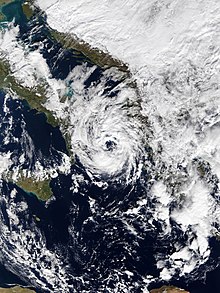|name=. Remove this parameter; the article title is used as the name by default. Numa over the Ionian Sea on 18 November, after peak intensity | |
| Meteorological history | |
|---|---|
| Formed | 11 November 2017 |
| Dissipated | 20 November 2017 |
| Tropical storm | |
| Highest winds | 100 km/h (65 mph) |
| Lowest pressure | 995 hPa (mbar); 29.38 inHg |
| Overall effects | |
| Fatalities | 22[1] |
| Damage | $100 million (2017 USD) €85 million (2017 Euro) |
| Areas affected | United Kingdom, Ireland, France, Italy, Tunisia, Greece, Turkey |
Cyclone Numa, also known as Medicane Numa,[2] was a Mediterranean tropical-like cyclone with the properties of a subtropical cyclone.[2][3][4][5][6] Numa formed on 11 November 2017 west of the British Isles, out of the extratropical remnants of Tropical Storm Rina, the seventeenth named storm of the 2017 Atlantic hurricane season. Subsequently, on 17 November, Numa acquired subtropical characteristics[7] before reaching peak intensity on 18 November,[2][8] becoming a rare "medicane". After making landfall in Greece on 18 November, Numa rapidly weakened, and was later absorbed into another extratropical storm on 20 November.[9] The flooding triggered by Numa became the worst weather event Greece had experienced since 1977,[10] and the storm caused an estimated $100 million (2017 USD) in damages in Europe.[1]
The National Observatory of Athens named the system Zenon.[10][11]
- ^ a b "Global Catastrophe Recap - November 2017" (PDF). Aon Benfield. 7 December 2017. p. 5. Archived from the original (PDF) on 12 December 2017. Retrieved 26 September 2018.
- ^ a b c Cite error: The named reference
Medicane Numawas invoked but never defined (see the help page). - ^ Sarah Fecht (22 November 2017). "'What we know about medicanes—hurricane-like storms in the Mediterranean". Phys.org. Retrieved 16 October 2021.
- ^ Raffaele Laricchia (19 November 2017). "'Ciclone tropicale Numa fa landfall in Grecia : venti oltre 110 km/h e nubifragi" [Tropical Cyclone Numa Fa Landfall in Greece: Twenty over 110 km / h and Nubifragi] (in Italian). InMeteo. Retrieved 16 October 2021.
- ^ Brett Gibbons (16 November 2017). "At least 11 die as deadly flash floods hit Greece". weather.com. The Weather Company. Archived from the original on 27 September 2018. Retrieved 16 October 2021.
- ^ Angela Fritz (16 November 2017). "This is what's behind the dramatic, deadly flooding in Greece". The Washington Post. Retrieved 17 November 2017.
- ^ Sullivan, Brian K. (22 November 2017). "Storm That Unleashed Deadly Floods in Greece Was a Rare 'Medicane'". bloomberg.com. New York, New York: Bloomberg. Retrieved 29 September 2020.
- ^ Cite error: The named reference
heading toward Greecewas invoked but never defined (see the help page). - ^ Cite error: The named reference
Nov 20 weather mapwas invoked but never defined (see the help page). - ^ a b Cite error: The named reference
Storm Numawas invoked but never defined (see the help page). - ^ Chrysopoulos, Philip (17 November 2017). "U.S. Meteorologist Explains Deadly Storm that Flooded Greek Towns". Greek Reporter. Retrieved 20 November 2017.